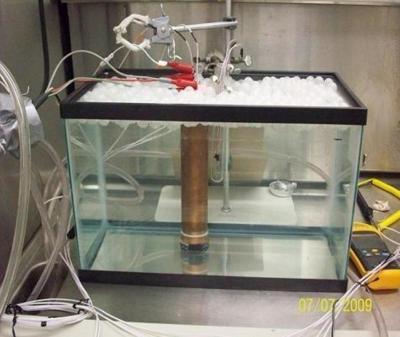At Annual Convention, Chemists Warm to Cold Fusion
Looking for new energy solutions, scientists are increasingly embracing the idea of cold fusion, once considered a junk science along...

Looking for new energy solutions, scientists are increasingly embracing the idea of cold fusion, once considered a junk science along the lines of alchemy. “Cold fusion” describes the nuclear fusion of atoms at close to room temperatures, as opposed to the epic temperatures at which nuclei fuse inside stars. If realized on a practical scale, it could provide the world with a virtually limitless source of energy.
Several new frontiers in cold fusion research are on display this week at the American Chemical Society’s annual meeting in San Francisco. One researcher is working on a new kind of battery that uses a new cold fusion process and has a longer shelf life than conventional batteries. Another researcher has experimental evidence that some forms of bacteria use a type of cold fusion, and their biologically driven transmutations could help dispose of nuclear waste.
German chemist Jan Marwan, who organized the Low-Energy Nuclear Reactions symposium at the ACS meeting, said scientists are no longer afraid to talk about cold fusion.
“I’ve also noticed that the field is gaining new researchers from universities that had previously not pursued cold fusion research. More and more people are becoming interested in it,” he said in a statement. “There’s still some resistance to this field. But we just have to keep on as we have done so far, exploring cold fusion step by step, and that will make it a successful alternative energy source.”
The term dates to 1989, when Martin Fleischmann of the University of Southampton and Stanley Pons of the University of Utah reported achieving nuclear fusion at room temperature with a simple device. Their claim ignited an international firestorm — which was soon quashed when no other scientists could duplicate their results. Soon after Fleischmann’s and Pons’ paper was published, cold fusion fell into disrepute. (Although it did have a brief starring role alongside Elisabeth Shue.)
But new research is bringing cold fusion toward mainstream acceptance, Marwan said. The number of papers on the topic has quadrupled since 2007, and several papers presented at the ACS conference use the term “cold fusion” or the “Fleischmann-Pons Effect” to describe the phenomenon, he said.
Here’s a glimpse at 5 promising pathways to cold fusion, courtesy of the American Chemical Society.
Cold Fusion Battery
George Miley, a researcher at the University of Illinois, is developing a type of cold fusion energy cell. The process would work by purposely creating defects in an electrolyte cell’s metal electrode. Deuterium atoms — also called heavy hydrogen atoms — migrate from the electrolyte into the defective electrode, where they pile up and get very dense. Then the atoms undergo a nuclear reaction, much like the cold fusion originally described by Fleischmann and Pons. Add in some energy conversion pieces, and the result is a battery that can produce electricity. The battery would last much longer than your average Duracell, thanks to the nuclear reactions.
New Calorimeter to Track Cold Fusion at Work
Melvin Miles, a researcher at Dixie State College in St. George, Utah, is working on a new type of calorimeter that could measure heat effects produced by electrochemical reactions. Built using store-bought copper tubing, a glass test tube and Mobil-1 oil, the calorimeter is very stable, allowing for accurate measurements of heat transfer.
The goal is to study cold fusion, but the calorimeter can also be used to study the heat created in other chemical reactions, Miles reports. He used the system to measure what happened when he charged an ammonium chloride solution, and found that it formed nitrogen trichloride and 50 megawatts of excess power.
Transmutation in Biological Systems
Ukrainian scientist Vladimir Vysotskii reports experimental evidence that certain bacteria can undergo a type of cold fusion process. In a talk scheduled for Monday afternoon, he was slated to describe studies of nuclear transmutation — the transformation of one element into another — in biological systems. His experiments examined stable and radioactive isotopes. Theoretically, cold fusion could be used to reduce nuclear waste.
Fuzzy Math
One of the most controversial aspects of cold fusion is excess heat production, which seems to violate laws of thermodynamics. Peter Hagelstein, a scientist at the Massachussetts Institute of Technology, has several new theoretical models that can help explain the excess heat production in cold fusion.
In a nuclear reaction, one would expect that the excess energy would appear as kinetic energy — but in the Fleischmann-Pons experiment, there are not as many energetic particles as there should be. Hagelstein’s models help explain the energy changes, by breaking large bits of energy into a lot of small bits.
A Cold Fusion Device That Uses Oil
During the heyday of cold fusion research, especially in Japan and Germany, much attention focused on making liquid fuels from coal, according to Tadahiko Mizuno, a researcher at Hokkaido University in Japan. In one such study, researchers observed large amounts of excess heat. Mizuno replicated that study to determine if he could control the excess heat effect.
He used phenanthrene, a heavy oil fraction, and subjected it to high pressure and heat in the presence of a metal catalyst. The reaction caused excess heat, strong gamma radiation and a slew of hydrocarbons. Mizuno also measured isotopes of elements ranging from hydrogen to lead.
He said the formation of hydrocarbons doesn’t account for the excess heat caused by the reaction. Heat production reached 60 watts — way higher than it should have been for chemical reactions.
“Overall heat production exceeded any conceivable chemical reaction by two orders of magnitude,” he wrote.